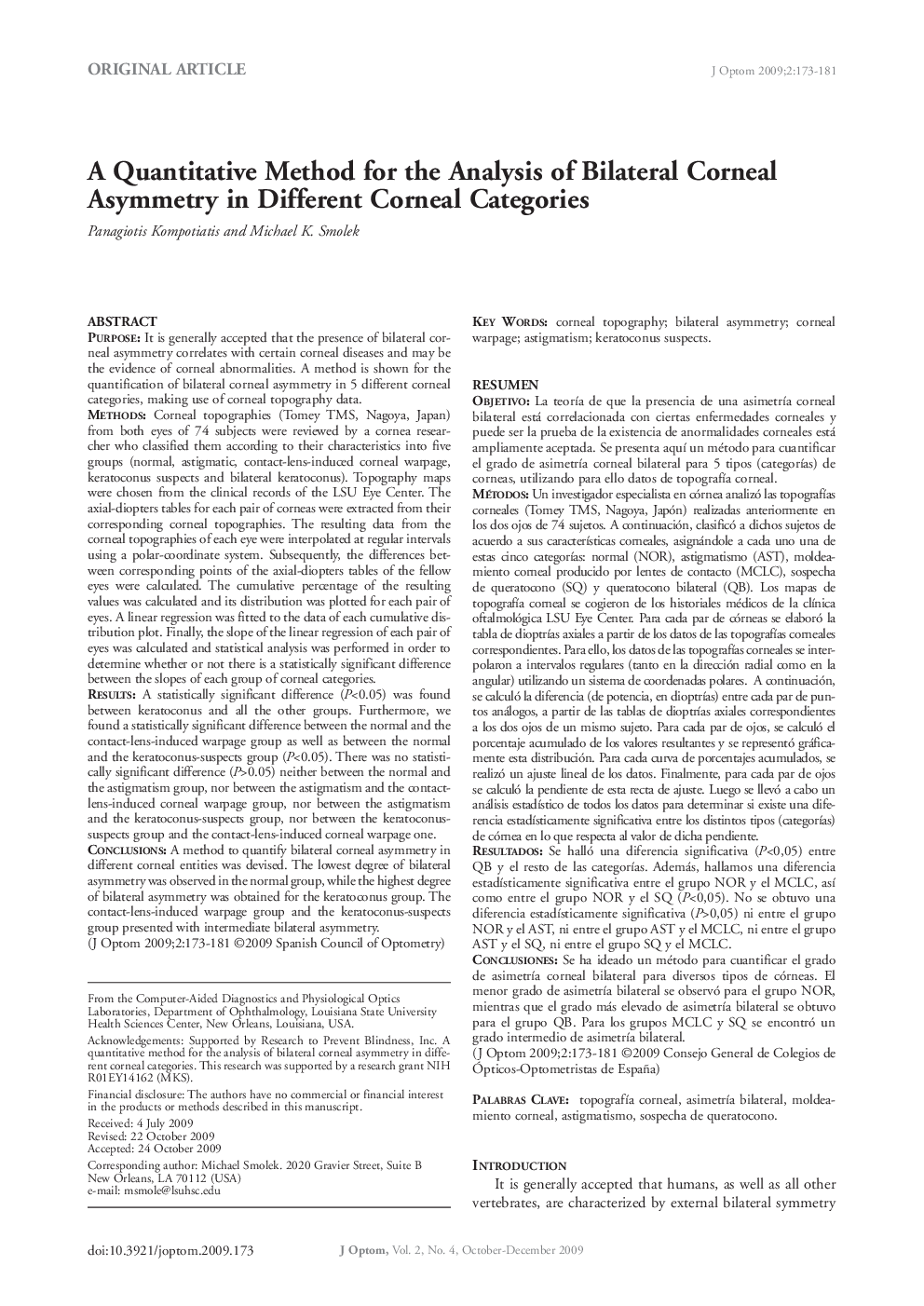| کد مقاله | کد نشریه | سال انتشار | مقاله انگلیسی | نسخه تمام متن |
|---|---|---|---|---|
| 2698715 | 1144060 | 2009 | 9 صفحه PDF | دانلود رایگان |

PurposeIt is generally accepted that the presence of bilateral corneal asymmetry correlates with certain corneal diseases and may be the evidence of corneal abnormalities. A method is shown for the quantification of bilateral corneal asymmetry in 5 different corneal categories, making use of corneal topography data.MethodsCorneal topographies (Tomey TMS, Nagoya, Japan) from both eyes of 74 subjects were reviewed by a cornea researcher who classified them according to their characteristics into five groups (normal, astigmatic, contact-lens-induced corneal warpage, keratoconus suspects and bilateral keratoconus). Topography maps were chosen from the clinical records of the LSU Eye Center. The axial-diopters tables for each pair of corneas were extracted from their corresponding corneal topographies. The resulting data from the corneal topographies of each eye were interpolated at regular intervals using a polar-coordinate system. Subsequently, the differences between corresponding points of the axial-diopters tables of the fellow eyes were calculated. The cumulative percentage of the resulting values was calculated and its distribution was plotted for each pair of eyes. A linear regression was fitted to the data of each cumulative distribution plot. Finally, the slope of the linear regression of each pair of eyes was calculated and statistical analysis was performed in order to determine whether or not there is a statistically significant difference between the slopes of each group of corneal categories.ResultsA statistically significant difference (P<0.05) was found between keratoconus and all the other groups. Furthermore, we found a statistically significant difference between the normal and the contact-lens-induced warpage group as well as between the normal and the keratoconus-suspects group (P<0.05). There was no statistically significant difference (P>0.05) neither between the normal and the astigmatism group, nor between the astigmatism and the contact-lens-induced corneal warpage group, nor between the astigmatism and the keratoconus-suspects group, nor between the keratoconus-suspects group and the contact-lens-induced corneal warpage one.ConclusionsA method to quantify bilateral corneal asymmetry in different corneal entities was devised. The lowest degree of bilateral asymmetry was observed in the normal group, while the highest degree of bilateral asymmetry was obtained for the keratoconus group. The contact-lens-induced warpage group and the keratoconus-suspects group presented with intermediate bilateral asymmetry.
ResumenObjetivoLa teoría de que la presencia de una asimetría corneal bilateral está correlacionada con ciertas enfermedades corneales y puede ser la prueba de la existencia de anormalidades corneales está ampliamente aceptada. Se presenta aquí un método para cuantificar el grado de asimetría corneal bilateral para 5 tipos (categorías) de corneas, utilizando para ello datos de topografía corneal.MétodosUn investigador especialista en córnea analizó las topografías corneales (Tomey TMS, Nagoya, Japón) realizadas anteriormente en los dos ojos de 74 sujetos. A continuación, clasificó a dichos sujetos de acuerdo a sus características corneales, asignándole a cada uno una de estas cinco categorías normal (NOR), astigmatismo (AST), moldeamiento corneal producido por lentes de contacto (MCLC), sospecha de queratocono (SQ) y queratocono bilateral (QB). Los mapas de topografía corneal se cogieron de los historiales médicos de la clínica oftalmológica LSU Eye Center. Para cada par de córneas se elaboró la tabla de dioptrías axiales a partir de los datos de las topografías corneales correspondientes. Para ello, los datos de las topografías corneales se interpolaron a intervalos regulares (tanto en la dirección radial como en la angular) utilizando un sistema de coordenadas polares. A continuación, se calculó la diferencia (de potencia, en dioptrías) entre cada par de puntos análogos, a partir de las tablas de dioptrías axiales correspondientes a los dos ojos de un mismo sujeto. Para cada par de ojos, se calculó el porcentaje acumulado de los valores resultantes y se representó gráficamente esta distribución. Para cada curva de porcentajes acumulados, se realizó un ajuste lineal de los datos. Finalmente, para cada par de ojos se calculó la pendiente de esta recta de ajuste. Luego se llevó a cabo un análisis estadístico de todos los datos para determinar si existe una diferencia estadísticamente significativa entre los distintos tipos (categorías) de córnea en lo que respecta al valor de dicha pendiente.ResultadosSe halló una diferencia significativa (P<0,05) entre QB y el resto de las categorías. Además, hallamos una diferencia estadísticamente significativa entre el grupo NOR y el MCLC, así como entre el grupo NOR y el SQ (P<0,05). No se obtuvo una diferencia estadísticamente significativa (P>0,05) ni entre el grupo NOR y el AST, ni entre el grupo AST y el MCLC, ni entre el grupo AST y el SQ, ni entre el grupo SQ y el MCLC.ConclusionesSe ha ideado un método para cuantificar el grado de asimetría corneal bilateral para diversos tipos de córneas. El menor grado de asimetría bilateral se observó para el grupo NOR, mientras que el grado más elevado de asimetría bilateral se obtuvo para el grupo QB. Para los grupos MCLC y SQ se encontró un grado intermedio de asimetría bilateral.
Journal: Journal of Optometry - Volume 2, Issue 4, 2009, Pages 173–181